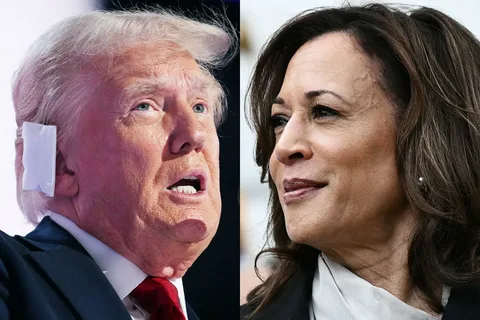Introduction
As Election Day approaches, the U.S. presidential race has captured global attention. With fluctuating poll numbers and intense campaigning, prediction markets like Polymarket offer a unique perspective on public sentiment by allowing users to bet on potential outcomes.
Recently, Polymarket data indicated that former President Donald Trump holds a 58.7% winning probability against Vice President Kamala Harris if the election were held today. Such figures add a compelling layer to traditional political analysis, as Polymarket harnesses collective betting insights that mirror evolving public perception.
In this post, we’ll dive into what the Polymarket data could mean for the upcoming election, how prediction markets work, and what the odds say about this critical contest.

Understanding Polymarket and Prediction Markets
Polymarket is one of several prediction platforms that allow users to place bets on a wide array of real-world events, including the outcomes of political elections. Unlike traditional polls, which merely capture public opinion at a specific moment, Polymarket operates as a decentralized prediction market where participants place monetary bets on the probability of different outcomes.
The logic behind prediction markets is based on “the wisdom of the crowd” — the theory that large groups of people make more accurate predictions when their collective judgment is combined.
Polymarket differs from conventional polling in several key ways:
- Betting-Based Model: Rather than recording opinions, Polymarket is driven by actual bets, which are often seen as a higher form of commitment than survey responses.
- Dynamic and Real-Time Adjustments: Polymarket odds adjust in real-time based on market sentiment and new information, creating a more fluid indicator of public sentiment.
- Reduced Partisan Bias: The monetary commitment required to place bets is thought to reduce bias, as users are financially incentivized to vote for their honest expectations.
This data-driven approach is especially important in this year’s race, as both Trump and Kamala Harris appeal to polarized voter bases. The Polymarket numbers are a unique indicator of how voters are interpreting campaign dynamics and economic conditions as Election Day nears.
Trump’s 58.7% Winning Probability: What It Signifies
As of the latest Polymarket data, Trump’s 58.7% probability suggests that bettors currently see him as more likely to secure a victory over Kamala Harris. This insight raises interesting questions, particularly given Trump’s divisive reputation and ongoing legal battles. However, this high probability might not solely reflect Trump’s personal popularity but could indicate broader trends influencing voter sentiment.
Key factors possibly affecting Trump’s Polymarket odds include:
- Economic Sentiment: Concerns about inflation and economic instability may lead voters to consider Trump’s economic track record favorably.
- Foreign Policy: Trump’s international policies resonate with certain voter bases who value a strong, America-first foreign policy.
- Harris’s Approval Ratings: Kamala Harris’s approval ratings have shown fluctuations, impacting her perceived electability as a presidential candidate.
These factors collectively shape Trump’s odds, especially in the context of recent polling and political developments that drive market predictions.
Comparing Polling Data and Prediction Market Probabilities
While traditional polling and prediction markets like Polymarket both provide insights into electoral outcomes, they operate with distinct methodologies. Polling data is based on surveys of selected populations, while prediction markets aggregate betting data, often adjusted in real-time. Understanding these differences is crucial when interpreting Trump’s 58.7% probability on Polymarket.
- Polling Strengths: Polls are structured to reflect population demographics, offering a snapshot of public sentiment. However, they often lack the dynamism of prediction markets.
- Polymarket’s Edge: The real-time nature of Polymarket gives it flexibility, allowing it to absorb news events faster than traditional polls.
For example, if a significant news event or policy announcement impacts Trump or Kamala Harris, Polymarket odds can shift almost instantly, while polling firms would require more time to reflect such changes in their next rounds. Therefore, Trump’s 58.7% odds might be a more sensitive barometer for tracking immediate public reactions compared to standard polling data.
Implications for Election Day and the Future of Prediction Markets
As Election Day nears, the numbers on Polymarket offer a window into potential outcomes but shouldn’t be interpreted as definitive. Factors like voter turnout, campaign strategies, and unforeseen events could sway either candidate’s chances. However, Polymarket provides an invaluable supplement to traditional forecasts, highlighting the potential for prediction markets to become influential tools in election forecasting.
The implications extend beyond this election. As prediction markets like Polymarket grow in popularity, they could play a more prominent role in shaping public perception and guiding political strategy. As more participants contribute, these platforms might evolve into primary reference points for real-time analysis of elections and other global events.
Conclusion
The Polymarket forecast showing Trump’s lead over Kamala Harris with a 58.7% probability adds a fascinating dimension to the 2024 presidential race.
This election cycle, dominated by economic concerns, public sentiment, and media influence, highlights the role of prediction markets in gauging public opinion beyond traditional polls. While Polymarket odds aren’t final predictors, they offer a dynamic snapshot of the race as Election Day approaches.
Do you think prediction markets offer more accurate insights than traditional polls? Share your thoughts in the comments below!






